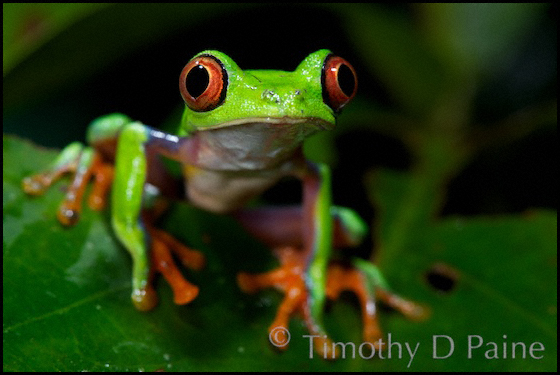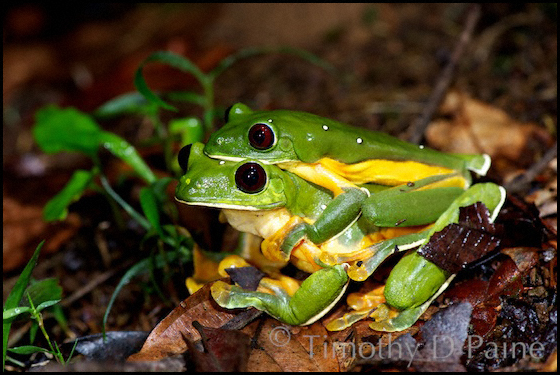Phyllomedusinae – of monkeys and frogs

Cruziohyla calacarifer found at Costa Rican Amphibian Research Center run by Brian Kubicki. Note the bicolored iris and similarly colored body to its sister species, C. craspedopus.
But all is not lost. There are a few good localities for C. calcarifer on the Caribbean slopes of Costa Rica but none are better than Brian Kubicki’s place near Siquirres. Brian’s home is also home to the Costa Rican Amphibian Research Center (CRARC). I plan on writing a bit more on his place in an upcoming blog article. But I have to say a bit about it now. That’s because soon after arriving I told him that my primary desire was to see a few new species, especially some leaf frogs. I didn’t have much time there and was a little skeptical when he told me “sure no problem.” I’ve heard that assurance countless times in the field. And while getting skunked I usually learn the basis comes from some sighting a couple years prior….at a particular tree. So I didn’t get my hopes up. But I soon learned that Brian knew his property, and the animals, well enough for his confidence. Because looking down a shallow ravine, in the beams of the flashlights, he pointed out several individuals clinging off vines and branches as they made their way down from the canopy. Wow! This is a stunning frog, matched only by its South American sister. There was even a tree hollow where egg masses clung to aerial roots dangling down. Inside the hollow I could see tadpoles wriggling up for a gulp of air. And the egg mass had the strange characteristic of containing eggless jelly capsules. A trait shared by members of Phyllomedusa but oddly not Agalychnis.

Its possible to confuse the misfit tree frog, Agalychnis saltator, with its sibling species A. callidryas, but its smaller size, blue-purple lateral striping, and more orangeish eyes will help identify it.
But Brian’s place was not just a haven for C. calcarifer. At CRARC you can easily see 5 of Costa Rica’s 6 leaf frog species, including the endangered Agalychnis lemur. In fact his place is one of a few known localities remaining for this slight and frail looking species. In 2005 Faivovich, et al., moved this species into the genus Hylomantis based on some shared physiology. But in 2009, using more genetic material, they suggest rectifying a resultant paraphyly of these genera by moving lemur back into Agalychnis, and possibly the other remaining species from Hylomantis. The only leaf frog missing from Brian’s place is A. annae, another endangered species now only found in a few localities in the central highlands of the country. At the guesthouse I found A. callidryas, the much photographed red-eye leaf frog. But more exciting for me was that I also found its sister species, A. saltator, a first for me. And once he took me into the forest we quickly arrived at a pond where aggregations of A. spurrelli come together to breed. The frogs climbed down their trees and oddly walked across the ground to reach the pond. There were amplectant pairs making their way to or in the vegetation above the water. Lone frogs were also sitting upright, possibly judging their direction and chances based on calling. A. spurrelliis one of the explosive breeding species of leaf frogs where massive aggregations form in a stunning spectacle.

A pair of amplexing Agalychnis spurrelli make their way towards a small pond where they’ll join others to lay their eggs on leaves overhanging the water.







12 comments
Great post Tim! Loved the shots.
Beautiful; well done and very interesting.
Beautiful photos and wonderful information…Thanks for sharing your experiences with us Tim….
Tim, these are some of the most stunning photos of Phyllomedusinae I have yet to come across. Keep up the great work!!!..
Peter
Peter, thanks for the compliments. I’m trying. Waaaay behind on the blog work as I’ve given to some other writing assignments but hoping to tap out more in 2014.
Hello everyone , I’m Alanis.
Welcome to my homepage . I started writing in middle school after a creative writing assignment for my English teacher. I did creative writing for almost a year before I thought about doing something else.
I had always loved doing research assignments because I’m passionate about learning. When you combine writing skill with a love of learning, research paper writing only makes sense as a job.
I’m passionate about helping the students of the future in their school career. When they get too busy, I am there to help.
Alanis – Writing Expert – Greaternewarkcharterschool Corp
My name is Everly. And I am a professional Content writer with many years of experience in writing.
My main focus is to solve problems related to writing. And I have been doing it for many years. I have been with several groups as a volunteer and have assisted clients in many ways.
My love for writing has no end. It is like the air we breathe, something I cherish with all my being. I am a full-time writer who started at an early age.
I’m happy that I`ve already sold several copies of my works in different countries like Canada and China and others too numerous to mention.
I also work in an organization that provides assistance to many people from different parts of the world. Students always come to me because I work no matter how hard their projects are. I help them to save energy, because I feel happy when people come to me for writing help.
Academic Writer – Everly – //nametheschool.com/]Nametheschool Band
мостбет промокод – мелбет промокод при регистрации, 1хбет промокод на сегодня
Change Reach For The Sky Anthology https://nytimes.ysr.org.uk/38.html Avalon The Remixes Vol 2 Part One
Grapefruit can increase the amount of this medication in your bloodstream. Consult your doctor or pharmacist for more details.
site
q0uqn5
bp0n38